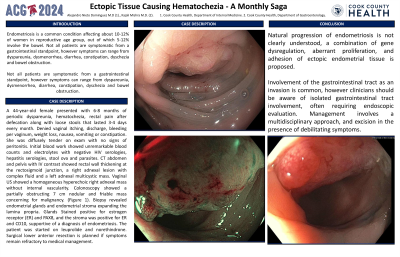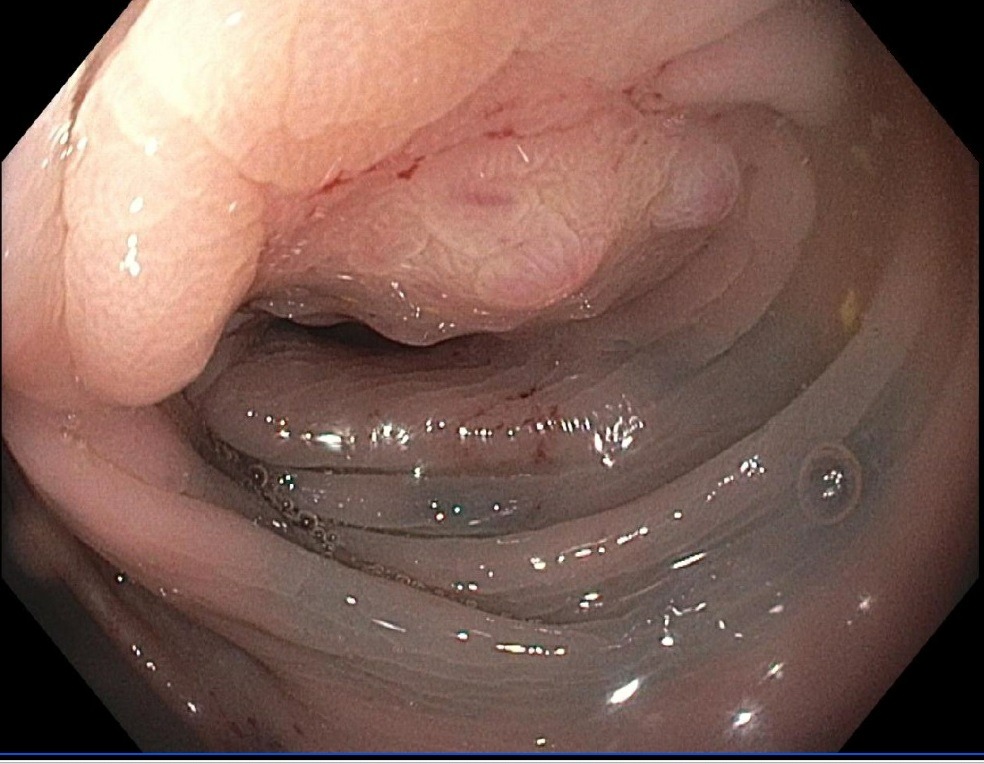Monday Poster Session
Category: Colon
P2101 - Ectopic Tissue Causing Hematochezia - A Monthly Saga
Monday, October 28, 2024
10:30 AM - 4:00 PM ET
Location: Exhibit Hall E


Alejandro J. Nieto Dominguez, MD
John H. Stroger, Jr. Hospital of Cook County
Chicago, IL
Presenting Author(s)
Alejandro J. Nieto Dominguez, MD1, Kajali Mishra, MD2
1John H. Stroger, Jr. Hospital of Cook County, Chicago, IL; 2Cook County Health and Hospital Systems, Chicago, IL
Introduction:
Endometriosis is a common condition affecting about 10-12% of women in reproductive age group, out of which 5-12% involve the bowel. Not all patients are symptomatic from a gastrointestinal standpoint, however symptoms can range from dyspareunia, dysmenorrhea, diarrhea, constipation, dyschezia and bowel obstruction.
Not all patients are symptomatic from a gastrointestinal standpoint, however symptoms can range from dyspareunia, dysmenorrhea, diarrhea, constipation, dyschezia and bowel obstruction.
Case Description/Methods: A 44-year-old female presented with 6-8 months of periodic dyspareunia, hematochezia, rectal pain after defecation along with loose stools that lasted 3-4 days every month. Denied vaginal itching, discharge, bleeding per vaginum, weight loss, nausea, vomiting or constipation. She was diffusely tender on exam with no signs of peritonitis. Initial blood work showed unremarkable blood counts and electrolytes with negative HIV serologies, hepatitis serologies, stool ova and parasites. CT abdomen and pelvis with IV contrast showed rectal wall thickening at the rectosigmoid junction, a right adnexal lesion with complex fluid and a left adnexal multicystic mass. Vaginal US showed a homogeneous hyperechoic right adnexal mass without internal vascularity. Colonoscopy showed a partially obstructing 7 cm nodular and friable mass concerning for malignancy. (Figure 1). Biopsy revealed endometrial glands and endometrial stroma expanding the lamina propria. Glands Stained positive for estrogen receptor (ER) and PAX8, and the stroma was positive for ER and CD10, supportive of a diagnosis of endometriosis. The patient was started on leuprolide and norethindrone. Surgical lower anterior resection is planned if symptoms remain refractory to medical management.
Discussion: Natural progression of endometriosis is not clearly understood, a combination of gene dysregulation, aberrant proliferation, and adhesion of ectopic endometrial tissue is proposed.
Involvement of the gastrointestinal tract as an invasion is common, however clinicians should be aware of isolated gastrointestinal tract involvement, often requiring endoscopic evaluation. Management involves a multidisciplinary approach, and excision in the presence of debilitating symptoms.

Disclosures:
Alejandro J. Nieto Dominguez, MD1, Kajali Mishra, MD2. P2101 - Ectopic Tissue Causing Hematochezia - A Monthly Saga, ACG 2024 Annual Scientific Meeting Abstracts. Philadelphia, PA: American College of Gastroenterology.
1John H. Stroger, Jr. Hospital of Cook County, Chicago, IL; 2Cook County Health and Hospital Systems, Chicago, IL
Introduction:
Endometriosis is a common condition affecting about 10-12% of women in reproductive age group, out of which 5-12% involve the bowel. Not all patients are symptomatic from a gastrointestinal standpoint, however symptoms can range from dyspareunia, dysmenorrhea, diarrhea, constipation, dyschezia and bowel obstruction.
Not all patients are symptomatic from a gastrointestinal standpoint, however symptoms can range from dyspareunia, dysmenorrhea, diarrhea, constipation, dyschezia and bowel obstruction.
Case Description/Methods: A 44-year-old female presented with 6-8 months of periodic dyspareunia, hematochezia, rectal pain after defecation along with loose stools that lasted 3-4 days every month. Denied vaginal itching, discharge, bleeding per vaginum, weight loss, nausea, vomiting or constipation. She was diffusely tender on exam with no signs of peritonitis. Initial blood work showed unremarkable blood counts and electrolytes with negative HIV serologies, hepatitis serologies, stool ova and parasites. CT abdomen and pelvis with IV contrast showed rectal wall thickening at the rectosigmoid junction, a right adnexal lesion with complex fluid and a left adnexal multicystic mass. Vaginal US showed a homogeneous hyperechoic right adnexal mass without internal vascularity. Colonoscopy showed a partially obstructing 7 cm nodular and friable mass concerning for malignancy. (Figure 1). Biopsy revealed endometrial glands and endometrial stroma expanding the lamina propria. Glands Stained positive for estrogen receptor (ER) and PAX8, and the stroma was positive for ER and CD10, supportive of a diagnosis of endometriosis. The patient was started on leuprolide and norethindrone. Surgical lower anterior resection is planned if symptoms remain refractory to medical management.
Discussion: Natural progression of endometriosis is not clearly understood, a combination of gene dysregulation, aberrant proliferation, and adhesion of ectopic endometrial tissue is proposed.
Involvement of the gastrointestinal tract as an invasion is common, however clinicians should be aware of isolated gastrointestinal tract involvement, often requiring endoscopic evaluation. Management involves a multidisciplinary approach, and excision in the presence of debilitating symptoms.

Figure: Figure 1. A 7 cm colonic mass proximal to the proximal Houston valve, extending from 23 cm to 16 cm, occupying about 50 % of the lumen, firm, with nodular and friable surface.
Disclosures:
Alejandro Nieto Dominguez indicated no relevant financial relationships.
Kajali Mishra indicated no relevant financial relationships.
Alejandro J. Nieto Dominguez, MD1, Kajali Mishra, MD2. P2101 - Ectopic Tissue Causing Hematochezia - A Monthly Saga, ACG 2024 Annual Scientific Meeting Abstracts. Philadelphia, PA: American College of Gastroenterology.
